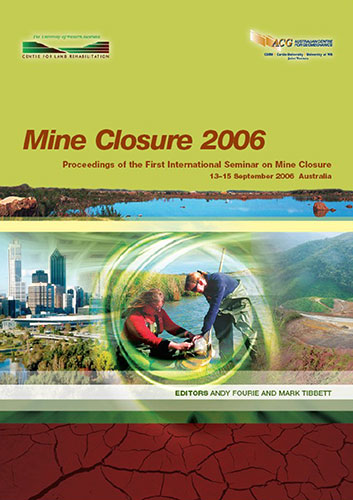Review of Environmental Performance Bonds in Western Australia

|
Authors: Cobby, G Paper is not available for download Contact Us |
DOI https://doi.org/10.36487/ACG_repo/605_Cobby
Cite As:
Cobby, G 2006, 'Review of Environmental Performance Bonds in Western Australia', in AB Fourie & M Tibbett (eds), Mine Closure 2006: Proceedings of the First International Seminar on Mine Closure, Australian Centre for Geomechanics, Perth, pp. 75-80, https://doi.org/10.36487/ACG_repo/605_Cobby
Abstract:
The Western Australian government has initiated a review of the environmental performance bond system to consider the adequacy of current regulatory policies and processes. Environmental performance bonds or mining securities serve to protect a State from financial liability should a mineral tenement owner fail to comply with mine site rehabilitation requirements. The review will determine whether alternate financial instruments such as insurance could optimise flexibility for the minerals industry whilst maintaining acceptable levels of financial risk for the State and the Minister. This paper provides information about the existing financial assurance system used in Western Australia. It describes the review objectives and considers current regulatory policy. As of June 2006, Australian government agencies collectively administer around A$2.0 billion in mining securities. The Western Australian Department of Industry and Resources (DoIR) administer A$480 million in performance bonds and securities and regulate around 500 active mine sites. The amount of mining security held is estimated to be 25% of the total cost of rehabilitation. By contrast, the Queensland government administer around $785 million for approximately 100 mine sites. The Queensland government hold securities for around 50% of the total cost of rehabilitation. Other Australian jurisdictions hold securities representing 40-50% of the total cost of rehabilitation (Table 3). Western Australia regulate the majority of Australian mine sites yet the value of securities held for mine site rehabilitation is significantly less than those required in other States. The Western Australian government appears to be accepting a higher level of financial risk exposure than other States and Territories. The review will consider whether the current regulatory policy provides the State with adequate financial protection. A working group of industry, government and community representatives has been formed to provide recommendations to the Minister. The review is scheduled for completion in 2007.
References:
New South Wales Department of Primary Industries (2005) Mining and the environment. www.minerals.nsw.gov.au.
Queensland Environmental Protection Authority (2003) Financial assurance for mining activities. www.epa.qld.gov.au.
Queensland Environmental Protection Authority (2004) A policy framework to encourage progressive rehabilitation of
large mines. www.epa.qld.gov.au.
Victoria Department of Sustainability and Environment (2006) Assessing mining proposals. www.dse.vic.gov.au.
Western Australian Department of Industry and Resources (2003) Guidelines – Environmental performance bonds.
www.doir.wa.gov.au.
Western Australian Department of Industry and Resources (2004) Policy Guidelines – Unconditional performance
bonds. www.doir.wa.gov.au.
Review of Environmental Performance Bonds in Western Australia G. Cobby
80 Mine Closure 2006, Perth, Australia
© Copyright 2025, Australian Centre for Geomechanics (ACG), The University of Western Australia. All rights reserved.
View copyright/legal information
Please direct any queries or error reports to repository-acg@uwa.edu.au
View copyright/legal information
Please direct any queries or error reports to repository-acg@uwa.edu.au